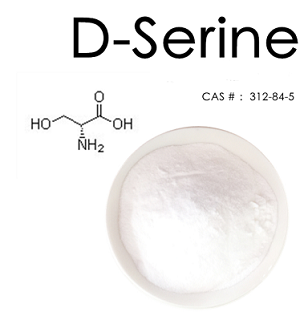D-Serin Chemische Eigenschaften,Einsatz,Produktion Methoden
R-S?tze Betriebsanweisung:
R36/37/38:Reizt die Augen, die Atmungsorgane und die Haut.
S-S?tze Betriebsanweisung:
S24/25:Berührung mit den Augen und der Haut vermeiden.
S36:DE: Bei der Arbeit geeignete Schutzkleidung tragen.
S26:Bei Berührung mit den Augen sofort gründlich mit Wasser abspülen und Arzt konsultieren.
Beschreibung
Serine is one of the 20 naturally-occurring amino acids used by all organisms in the biosynthesis of proteins. Having a single chiral center, serine can exist as one of two stereoisomers (L-Serine and D-Serine).
D-serine is categorized as a nootropic. It is an amino acid found in the brain and is produced primarily in astrocytes; the conversion of L-serine to D-serine is catalyzed by the serine racemase enzyme. D-serine acts as a co-agonist of glutamate NMDA receptors and binds at the glycine site. NMDA receptors mediate synaptic plasticity, synaptogenesis, excitotoxicity, memory acquisition, and learning. Schizophrenia is characterized by reduced NMDA receptor signaling and therefore, D-serine supplementation has been tested extensively in patients with schizophrenia. It is thought to improve cognitive symptoms in this population. It is worth noting that in Alzheimer’s disease, there is excess glutamate receptor activation. Memantine, one of the drugs used to treat Alzheimer’s disease, is an NMDA receptor antagonist.
Chemische Eigenschaften
D-serine is a off-white crystalline powder with a faint musty odor.It is an amino acid found in the brain. Derived from Glycine, d-serine is a neuromodulator, meaning it regulates the activities of neurons.

D-Serine supplementation can reduce symptoms of cognitive decline. It is also able to reduce symptoms of diseases characterized by reduced N-methyl-D-aspartate (NMDA) signaling, which includes cocaine dependence and schizophrenia.
Verwenden
D-Serine is involved in the biosynthesis of purines, pyrimidines, and other amino acids. D-Serine also is an agonist of glycine site of the NMDA-type glutamate receptor. It also acts as Lacosamide intermediate.
Definition
D-serine is the R-enantiomer of serine. It has a role as a NMDA receptor agonist, a human metabolite and an Escherichia coli metabolite. It is a D-alpha-amino acid and a serine. It is a conjugate base of a D-serinium. It is a conjugate acid of a D-serinate. It is an enantiomer of a L-serine. It is a tautomer of a D-serine zwitterion.
Application
D-serine has been used as a substrate in D-amino acid oxidase (DAO) activity in human 1321N1 astrocytoma cells. It has also been used in intracerebroventricular administration in rat for the induction of antinociceptive effect.
D-serine has been used to prevent glycine-dependent desensitization of N-methyl D-aspartate receptor (NMDAR) and to study its effects on NMDARs to correct behavioral abnormalities in rats after partial sciatic nerve ligation (PSNL).
Allgemeine Beschreibung
D-serine is an unusual amino acid expressed in the mammalian brain.
Biologische Aktivit?t
D-serine is an agonist and glycine mimic which is active at the strychnine-insensitive glycine binding site associated with the N-methyl-D-aspartate (NMDA) receptor as well as the inhibitory post-synaptic glycine receptor. Along with glutamate, it has a role in various physiological processes including synaptic plasticity and receptor transmission. Dysregulation of D-serine signaling has been linked with neurodegenerative diseases and disorders.
D-serine is essential for the normal development of dendrites, neuroblast migration and may have therapeutic potential for treating schizophrenia and depression states. The levels of D-serine is elevated in traumatic brain injury (TBI).
D-Serin Upstream-Materialien And Downstream Produkte
Upstream-Materialien
Downstream Produkte

